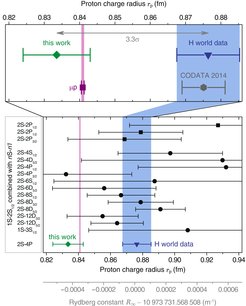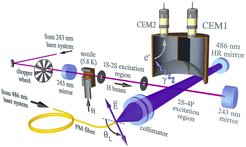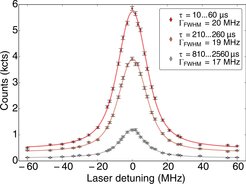2S-nP Spectroscopy
The Rydberg Constant and Proton Radius from Hydrogen Spectroscopy
The 2S-nP project is currently the main focus of our research. This project is aiming for a new determination of the Rydberg constant {$R_\infty$} and the proton root mean square (RMS) charge radius {$r_\mathrm{p}$} from precision spectroscopy of atomic hydrogen (H). The precise extraction of these parameters from different experiments is an essential ingredient for stringent tests of the consistency of quantum electrodynamics (QED). The Rydberg constant plays a special role in these tests because it connects multiple fundamental constants:
\begin{equation} R_\infty=\frac{m_e \alpha^2c}{2h}. \end{equation}

To extract {$R_\infty$} and {$r_\mathrm{p}$} from H spectroscopy, at least two distinct transition frequencies are needed as input. Because the 1S-2S transition frequency is known with much higher precision than any of the other transition frequencies, it serves as a corner stone in this determination. Fig. 1 shows the result of this determination, using the different available results from H spectroscopy. Note that since {$R_\infty$} and {$r_\mathrm{p}$} are highly correlated, the values can be shown in one plot with two axes. The results from H spectroscopy are compatible with each other, with a weighted average of these results giving the value shown as H world data. There is, however, a four standard deviation ({$\sigma$}) discrepancy between this H world data value and the value determined from laser spectroscopy of muonic hydrogen (µp) [1]. An even larger discrepancy of 5.6{$\sigma$} is obtained when elastic electron scattering and deuterium spectroscopy data are included in the analysis (CODATA 2014 in Fig. 1). So far, it is unclear what causes this so-called "proton size puzzle", with suggested solutions covering the entire spectrum from experimental errors up to physics beyond the standard model.
Laser spectroscopy of the 2S-4P transitions
This situation calls for additional experimental data. Utilizing the 1S-2S beam apparatus as a well-controlled and reliable cryogenic source of hydrogen atoms in the metastable 2S state, we are currently measuring transition frequencies from the 2S state to higher lying P-states in H. In particular, we are studying the 2S-4P transition at 486 nm, since this laser wavelength corresponds to twice the wavelength needed for the 1S-2S experiment and thus a well-characterized laser is available to us.
Achieving the desired accuracy of a few parts in {$10^{-12}$} needed to improve on previous measurements is an technologically and experimentally challenging task. In particular, this accuracy corresponds to determining the center of the 2S-4P atomic resonance to an uncertainty on the order of {$10^{-4}$} of its observed width of 20 MHz (resulting from the natural line width {$\Gamma = 2\pi \times 12.9\,\mathrm{MHz}$} and additional broadening mechanisms). Such a high resolution requires both a well-understood apparatus and a deep theoretical understanding of the atomic dynamics involved.

A schematic view of our experimental setup for 2S-4P spectroscopy [2] is shown in Fig. 2. H thermalizes at the inner walls of a copper nozzle held at 5.8 K by a cryostat. The emerging atomic beam is collimated by two apertures and overlaps with 243 nm radiation from a preparation laser circulating in an enhancement cavity. This radiation allows for a Doppler-free two-photon excitation of the 1S-2S transition, resulting in H in the 2S state. In contrast to electron-impact excitation, the standard scheme of 2S excitation for the optical measurements shown in Fig. 1, this optical excitation scheme preserves the atoms' low thermal velocity and almost exclusively populates one of the Zeeman sublevels (the {$\mathrm{2S}_{1/2}^{F=0}$} level).
Excitation of the 2S-4P transition takes place in a separated region. Here, light from the spectroscopy laser at 486 nm crosses the beam of 2S atoms at an angle close to 90°. In this way, the first-order Doppler shift due to motion of the atoms relative to the propagation direction of the laser light is minimized. To further suppress the Doppler shift, which constitutes the biggest source of uncertainty for this measurement, we developed the active fiber-based retroreflector (AFR) [3] scheme. In this scheme, the transition is simultaneously driven by two actively-stabilized, antiparallel phase-retracing laser beams, resulting in Doppler shifts of equal magnitude, but opposite signs and thus no net shift of the resulting line shape. The 4P state rapidly decays back to the 1S ground state, emitting a Lyman-{$\gamma$} photon. The photoelectrons ejected by these energetic photons from our graphite-coated detector walls are detected in channel electron multipliers CEM1 and CEM2 and the output of these detectors is our signal. By scanning the frequency of the spectroscopy laser, the 2S-4P resonance can recorded, with typical examples of the resulting data shown in Fig. 3. We periodically switch off the preparation laser and thus the production of 2S atoms using a chopper wheel and record the signal as a function of delay time. Different delay times then correspond to the sampling of different atomic velocity groups (see different curves in Fig. 3). With this, we can experimentally confirm the validity of the Doppler shift suppression by evaluating the resonance position as a function of atomic velocity.

In order to determine the transition frequency to a precision of a few parts in 1012, the atomic resonance has to be sampled many thousands of times and the results averaged.


